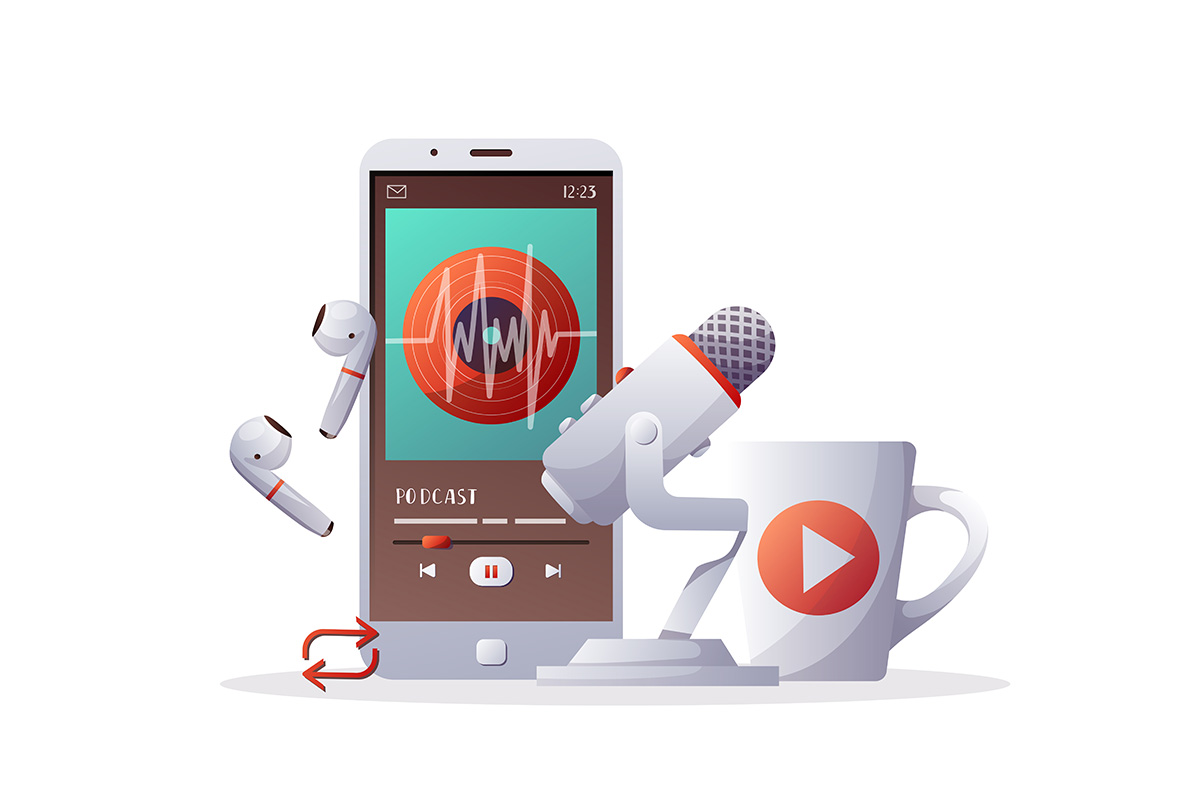Podcast advertising has become one of the most effective ways for businesses to increase brand awareness and drive sales. It’s even a viable way to promote other podcasts.
What makes podcast advertising so great compared to other channels?
87% of podcast listeners say they pay attention to the ads during podcasts. 54% of those people say they’re more likely to consider a brand that was advertised after hearing them promoted on a podcast, and 60% have purchased something from a podcast ad.
But success with podcast advertising isn’t guaranteed. You can’t just haphazardly put an ad together, send it to any podcast, and expect six in ten people to buy what you’re promoting—it doesn’t work that way.
This in-depth guide explains everything you need to know about podcast advertising, including the costs, types of podcast ads, and actionable steps for getting started. Let’s dive in!
What is Podcast Advertising?
Podcast advertising gives businesses and brands the ability to pay for a promotion or pitch during a podcast episode. These promotions can come in many different forms, including a plug directly from the host or a more traditional commercial break inserted within the show.
Podcast ads allow you to speak directly to potential customers through an audio message.
Most podcast ads range between 15 and 60 seconds. They can be pre-recorded, or read live during the episode. This is a relatively new type of advertising since podcasts haven’t even been around for two decades. Dynamic ad insertion into podcasts didn’t get introduced until 2013, and streaming ad insertions weren’t available until 2020.
Regardless of the format, any paid promotion that occurs before, during, or after a podcast episode falls into the category of podcast advertising.
How Much Does Podcast Advertising Cost?
The cost to run a podcast ad varies on several factors, including the ad type and the show. Here’s a look at the industry standard podcast rates, according to Advertisecast—the monetization marketplace from Libsyn Podcast hosting.
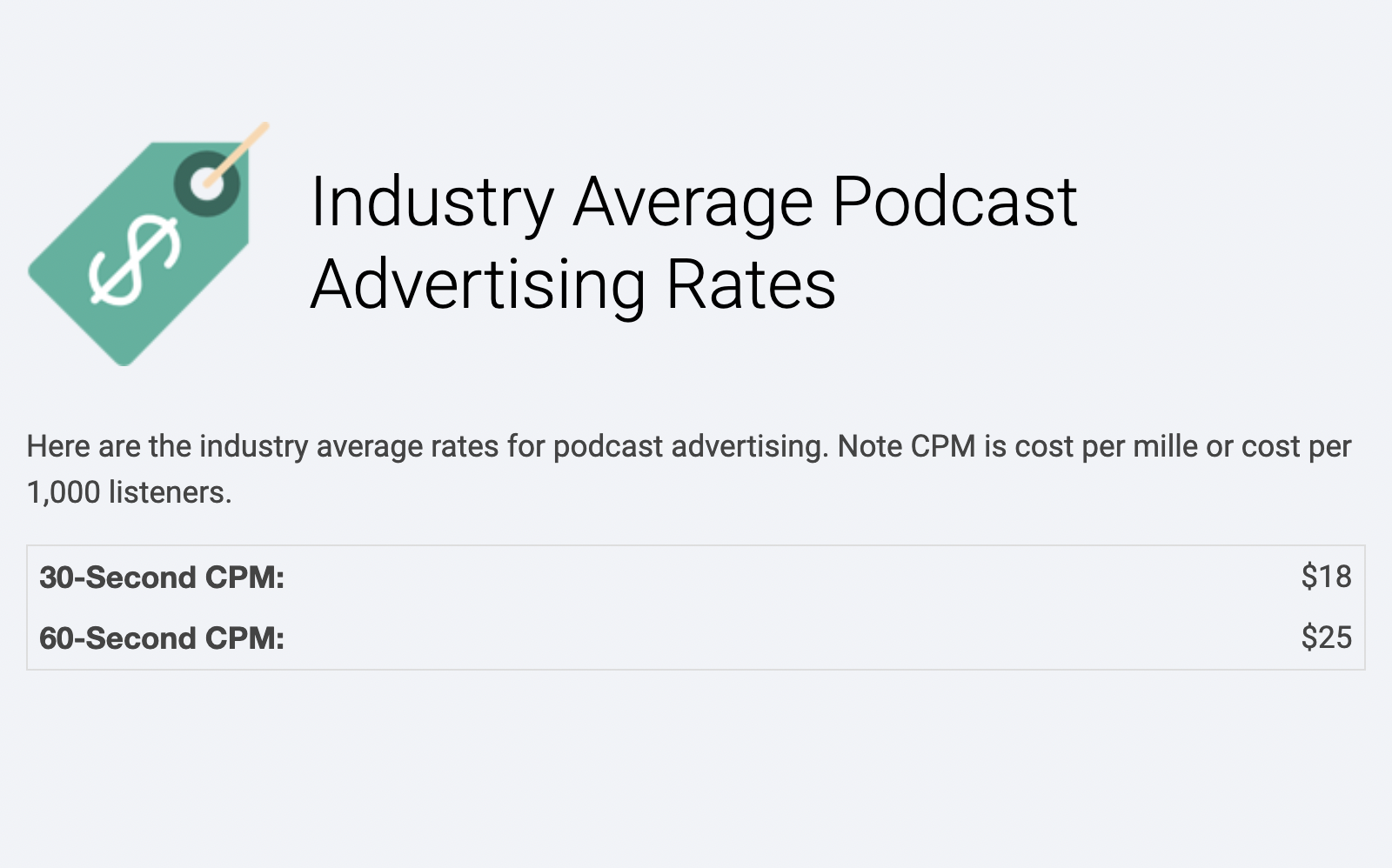
The average rate of a 30-second podcast ad, based on the CPM pricing model, is $18, and the average rate of a 60-second CPM ad is $25.
But like many averages, these industry standards don’t tell the full story. For example, you can quickly find dozens of podcasts on Advertisecast that have CPMs starting at $40.
A handful of podcasts even offer CPMs as low as $5.
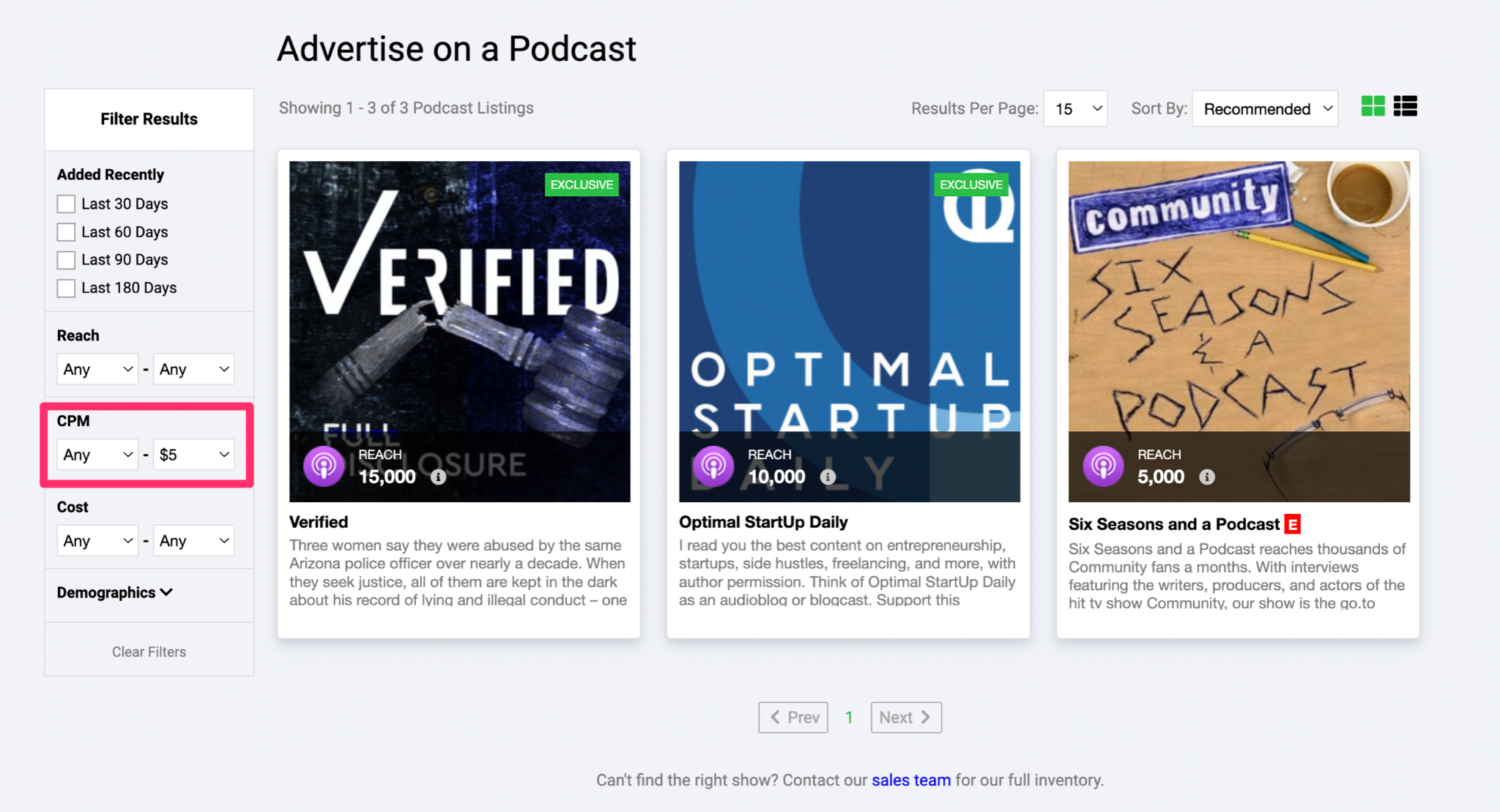
Generally speaking, you can expect cheaper podcast ads to be newer and have a lower reach. The most expensive ads tend to come from popular, well-established podcasts with a larger reach.
You can think of this like any other type of advertisement. It’s going to cost you more money to run an ad during the Super Bowl compared to an ad during a preseason game.
Aside from the cost per ad, many podcasts require you to spend a minimum amount of money on your ads for them to consider your business. For example, recent reports suggest the minimum ad spending requirement for Joe Rogan’s podcast is $1 million.
How Podcast Pricing Works
Beyond the dollar cost associated with a podcast ad, you need to understand how different pricing models work. These are the three most popular types of podcast ad pricing models:
- Cost per mile (CPM) — This is the cost per 1,000 impressions or 1,000 listeners. An impression counts based on the number of times an episode with the ad has been downloaded. Some podcasts may base this number on the total number of subscribers to a channel. CPM is the most common type of podcast ad pricing model.
- Cost per acquisition (CPA) — With the CPA model, you pay a fixed amount or percentage based on every new customer you acquire through an ad. For example, you might give podcast hosts a unique promo code to share during the pitch. Jay Shetty might tell his listeners to “use code ‘Jay25’ to get 25% off your first purchase with [your brand].” This model is often more expensive than CPM, but you’re only paying based on results—making it easy to identify your customer acquisition costs and justify the spending.
- Flat Rate — This is far less common than CPM or CPA. But some hosts charge businesses a flat rate to advertise on a show—regardless of how many listeners or acquisitions it yields.
Types of Podcast Ads
Price aside, podcast ads come in all different shapes and sizes. Here’s a closer look at the most common types of podcast advertising formats:
- Dynamically Inserted Ads — Dynamic ads are recorded and produced separately from the episode. They could be read by the host, but they may also be recorded by the brand that’s being promoted. You can think of these like a traditional commercial that you’ll hear on the radio. They’re inserted into the show when the episode gets downloaded or streamed. Each listener might also hear different ads.
- Baked-In Advertisements — As the name implies, these ads are “baked into” the show. They could still be scripted, but they’re often read live by the host. Hosts might even be given some room to adlib and present the ad using their own unique style. For example, during the script, the host might say something like “I have a pair of these pants myself, and truly love them.” Baked-in ads feel more like they’re part of the show instead of an intrusion.
- Pre-Roll Ads — These ads play at the beginning of the show. They can occur before the show actually starts or during the introduction. For example, the host might say, “Today’s show is brought to you by [brand],” before pitching the brand’s slogan and sharing a promo code.
- Mid-Roll Ads — Mid-rolls play during the show, around the halfway mark. They could be baked-in or dynamically inserted.
- Post-Roll Ads — As you’d expect from the name, a post-roll ad plays when the episode is over.
Cost varies by ad type as well. For example, a post-roll ad is typically less expensive than a pre-roll or mid-roll since the audience might skip it altogether. The show is over, so they don’t have much of an incentive to keep listening just to hear an ad.
How to Get Started With Podcast Advertising
Now that you understand how podcast advertising works, it’s time to get started with your own ads. If it’s your first time going through this process, just follow the step-by-step tutorial below.
Step #1 — Determine Your Budget
The first thing you need to do is figure out how much money you want to spend. Rather than looking at the CPM or CPA rates, it’s better to first approach this from your total advertising budget.
How much money are you going to spend on ads this year? What percentage of your total advertising budget will be allocated to podcast advertising?
Research suggests that podcast ads account for one-fourth of digital and audio advertising budgets in the US. This is projected to reach one-third by 2026.
So if you want to align with national averages, you can set aside 20% to 30% of your advertising budget for podcasts.
You don’t need to try and keep up with the big companies spending millions on podcast ads.
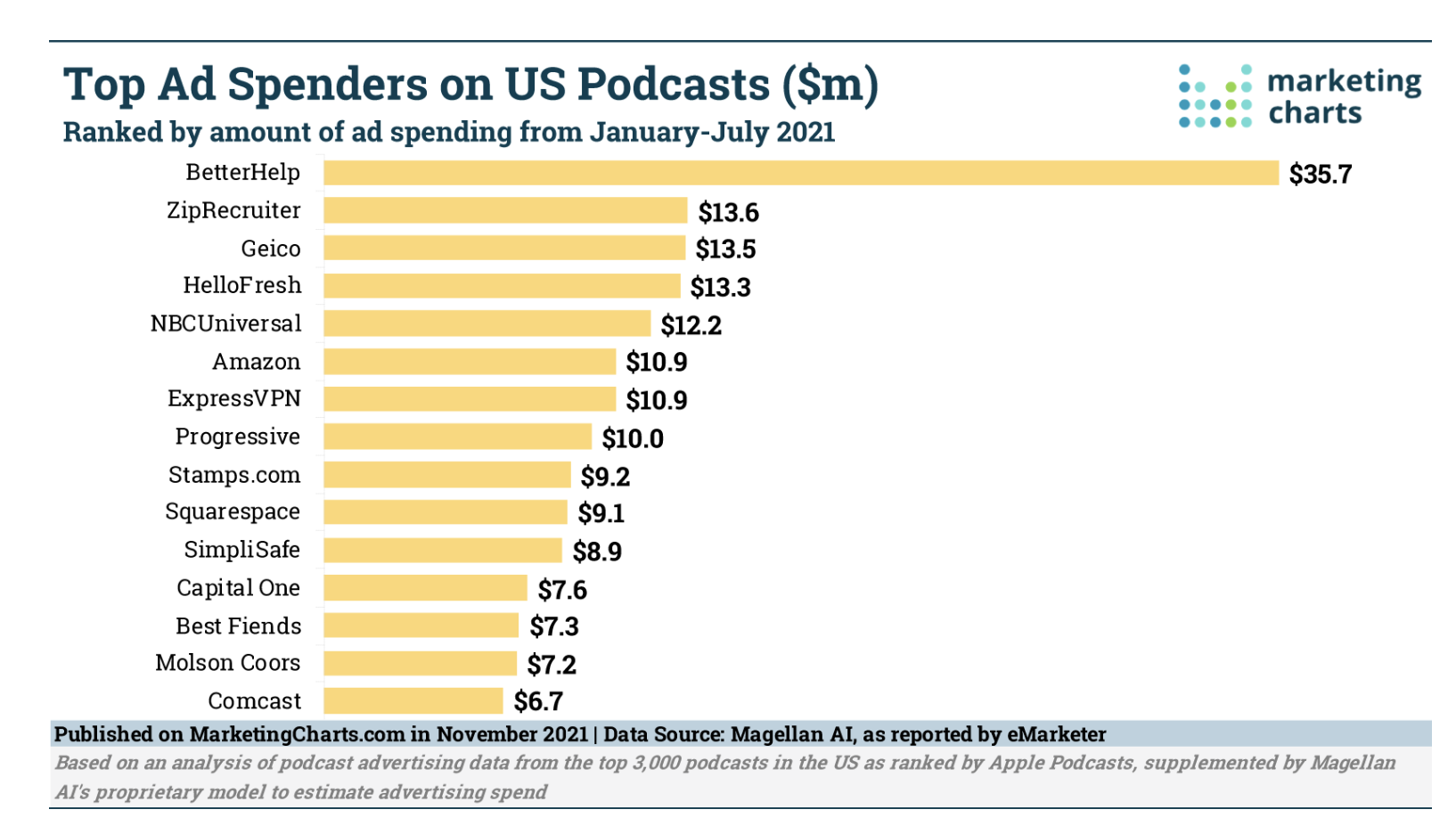
Just stick within your budget, and don’t overextend yourself.
Step #2 — Choose the Right Types of Ads
Next, you need to decide which types of ads you want to run. This varies based on your business type and promo.
For example, subscription services would likely benefit more from running CPA ads that are mid-roll.
If you’re on a really tight budget, you might need to consider running post-roll ads to start to get the best price. You just can’t expect to generate a ton of results here. So there’s always going to be a trade-off between when your ads get run, the cost, and how much of an impact they have on your business.
The types of ads you want to run, along with your budget, can help you pre-qualify some candidates—which we’ll cover in the later steps.
Step #3 — Create Your Podcast Ads
This part is fairly straightforward. You’ll either be recording ads on your own, creating scripts to send to podcast hosts, or both.
Regardless of the scenario, you should create various versions of your ads and various lengths.
For example, you might create two versions of a 15-second ad, three versions of a 30-second ad, three versions of a 45-second ad, and two versions of a 60-second ad.
You want to give yourself lots of options to choose from when you’re looking to fill slots on shows. Variations of ads can also help you test the results if each one has a unique promo code. You could ultimately discover that your 30-second ads are the most effective, and focus more on those moving forward.
Step #4 — Reach Out to the Right Podcast
When you’re searching for the right podcast, keep the following considerations in mind:
- Does the podcast’s content match my brand?
- Is the podcast’s audience aligned with my target market?
- How much is the podcast charging for ads?
- Does the host have the same core values and mission as my business?
In some instances, it’s worth it to pay a premium for podcasts that align perfectly with your goals and the audience you’re trying to reach. For example, you can be happy to pay more if you’re advertising custom golf clubs on a golf podcast. Advertising those clubs on a home cooking podcast may not be as relevant and shouldn’t cost as much.
If you’re looking through Advertisecast for opportunities, make sure you pay close attention to the audience demographics section of a show.
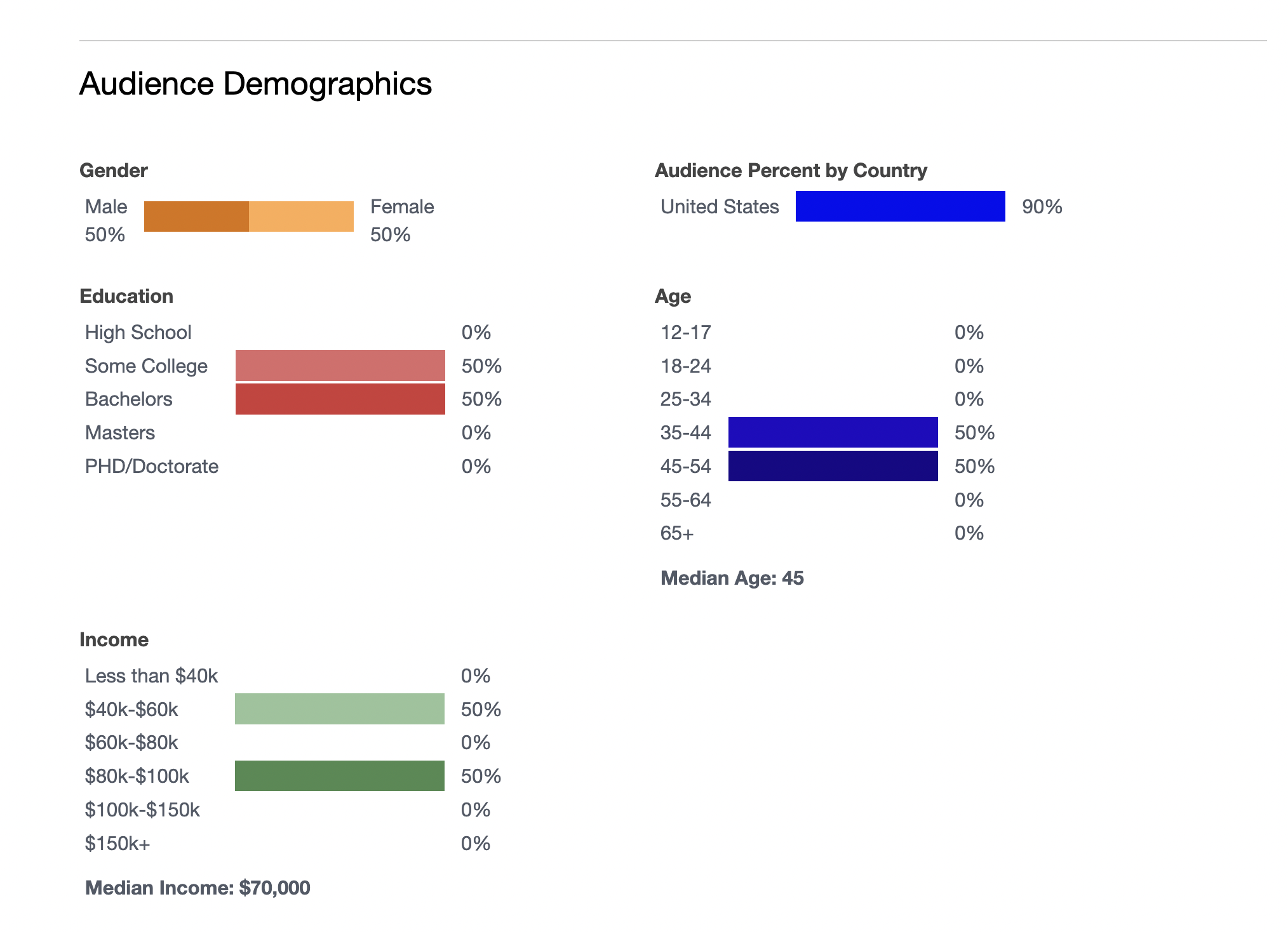
Other advertising platforms should have similar information. You can also ask the show directly for more audience insights.
Strep #5 — Track and Monitor the Results
Podcast advertising isn’t a set-it-and-forget-it initiative. You still need to monitor the results after you’ve launched the ads to ensure you’re getting the most out of your investment.
You can run different ads in cycles to see how they perform on different shows, in front of different audiences, or at different times of the year.
That’s why it’s so important to have a wide range of ads at your disposal (think back to step #3), so you can easily make adjustments on the fly.
Then you can continue running ads that work and scrap the ones that aren’t generating results.
Final Thoughts
I hope you found this beginner’s guide to podcast advertising helpful. With podcast trends growing exponentially, it’s important to build a solid podcast advertising strategy today—making it easier for you to scale moving forward.
Reach out to our team here at McDougall Interactive if you have any other questions about podcast advertising, or need some assistance with any of your digital initiatives.

